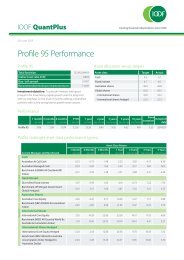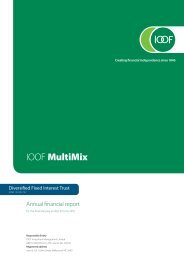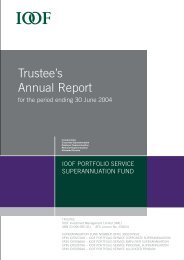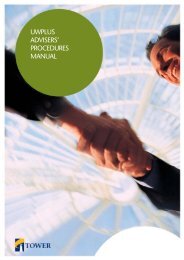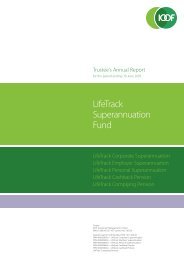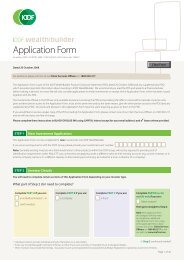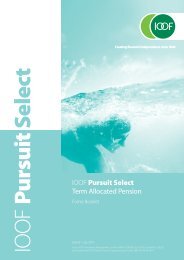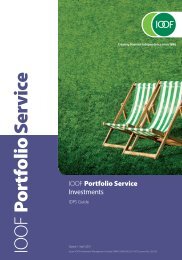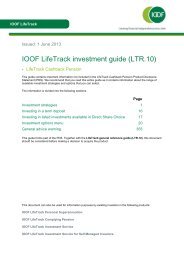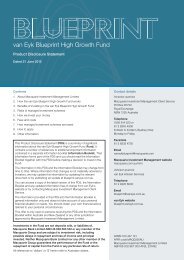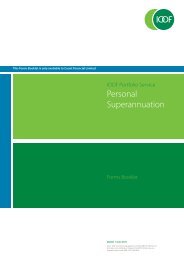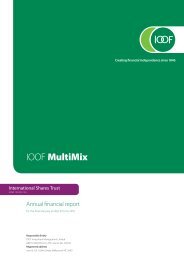annual report 2011
annual report 2011
annual report 2011
You also want an ePaper? Increase the reach of your titles
YUMPU automatically turns print PDFs into web optimized ePapers that Google loves.
IOOF | <strong>annual</strong> <strong>report</strong> <strong>2011</strong><br />
Notes to the financial statements (cont’d)<br />
For the year ended 30 June <strong>2011</strong><br />
investment contract liability. Distributions on these contracts<br />
are charged to profit or loss as an expense.<br />
Where contracts contain both an investment component and<br />
an insurance component and the deposit component can be<br />
separately measured, the underlying amounts are unbundled.<br />
Premiums relating to the insurance component are accounted<br />
for through profit or loss and the investment component is<br />
accounted for as a deposit through the statement of financial<br />
position as described above.<br />
(l)<br />
Revenue<br />
Revenue is measured at the fair value of the consideration<br />
received or receivable.<br />
(i)<br />
Management fees<br />
The Group provide management services to unit trusts and<br />
funds operated by the Group at normal commercial rates.<br />
Management fees earned from the unit trusts and funds are<br />
calculated based on an agreed percentage of the respective<br />
funds under management or administration as disclosed in the<br />
respective product disclosure statements, and are recognised<br />
on an accruals basis.<br />
Management and service fees revenue from the provision of<br />
financial advisory services together with revenue from the<br />
rendering of services are recognised at the time the service is<br />
provided.<br />
(ii)<br />
Other fee revenue and stockbroking revenue<br />
Other fee revenue and stockbroking revenue from the<br />
rendering of services are recognised at the time the service is<br />
provided.<br />
(iii) Upfront service fees<br />
Upfront service fees are recorded as deferred revenue and<br />
recognised on a straight-line basis over a period that is<br />
reflective of the continued service provided. The period of<br />
amortisation is based on historical experience and varies<br />
between products on offer. The current deferral period is<br />
between 5 and 7 years. These upfront service fees are recorded<br />
as a deferred revenue liability within other liabilities in the<br />
consolidated statement of financial position.<br />
(iv) Premium revenue<br />
Premium revenue is earned on life insurance products. Life<br />
insurance premiums with no due date are recognised on a<br />
cash received basis. Premiums with regular due dates are<br />
recognised as revenue on a basis which is consistent with<br />
the Actuary’s valuation of liabilities. Deposit components of<br />
life insurance contracts are not revenue and are treated as<br />
movements in life insurance contract liabilities.<br />
(m) Lease payments<br />
Payments made under operating leases are recognised in<br />
profit or loss on a straight-line basis over the term of the lease.<br />
Lease incentives received are recognised as an integral part of<br />
the total lease expense, over the term of the lease.<br />
Minimum lease payments made under finance leases are<br />
apportioned between the finance expense and the reduction<br />
of the outstanding liability. The finance expense is allocated to<br />
each period during the lease term so as to produce a constant<br />
periodic rate of interest on the remaining balance of the<br />
liability.<br />
(n) Finance income and finance costs<br />
Finance income comprises interest income on funds invested<br />
(including available-for-sale financial assets), dividend income,<br />
gains on the disposal of available-for sale financial assets,<br />
changes in the fair value of financial assets at fair value through<br />
profit or loss, and gains on hedging instruments that are<br />
recognised in profit or loss. Interest income is recognised as it<br />
accrues in profit or loss, using the effective interest method.<br />
Dividend income is recognised in profit or loss on the date that<br />
the Group’s right to receive payment is established, which in<br />
the case of quoted securities is the ex-dividend date.<br />
Finance costs comprise interest expense on borrowings,<br />
unwinding of the discount on provisions, changes in the fair<br />
value of financial assets at fair value through profit or loss,<br />
impairment losses recognised on financial assets, and losses on<br />
hedging instruments that are recognised in profit or loss.<br />
Borrowing costs that are not directly attributable to the<br />
acquisition, construction or production of a qualifying asset are<br />
recognised in profit or loss using the effective interest method.<br />
(o) Income tax<br />
Income tax expense comprises current and deferred tax.<br />
Current and deferred tax are recognised in profit or loss except<br />
to the extent that it relates to a business combination, or<br />
items recognised directly in equity or in other comprehensive<br />
income.<br />
Current tax is the expected tax payable or receivable on<br />
the taxable income for the year, using tax rates enacted<br />
or substantively enacted at the <strong>report</strong>ing date, and any<br />
adjustment to tax payable in respect of previous years.<br />
The applicable rates of income tax vary depending upon the<br />
fund or entity involved. The segregated superannuation and<br />
rollover fund business of the IOOF Ltd benefit funds attracts<br />
income tax at the rate of 15% (2010: 15%) and the ordinary<br />
business of the Company is taxed at the rate of 30% (2010:<br />
30%).<br />
page 62



